TAPAS.network | 6 June 2023 | Commentary
Is changing fares the route to more public transport use and modal shift?
Would more people choose bus and rail travel if lower fares were charged? And is it the absolute level of fares which is significant, or their relative levels compared with the cost of car use? Perhaps the nature of the tariff structure, the method of payment for individual journeys or the opportunities for daily or period single-area or system-wide ‘freedom passes’ or discount deals is a significant factor in making bus and rail use more attractive? This multi-authored TAPAS article looks at the available evidence, and some recent new pricing initiatives
A COMMON REFRAIN from campaigners is that if only public transport was cheaper or even free it would get people out of their cars. The new English national maximum £2 bus fare, first introduced for just three months, and now extended, and some pricing schemes as part of the Bus Service Improvement Plans funding are testing that hypothesis, along with recently implemented significantly discounted public transport fares initiatives in Spain and Germany. These have come partly to address the cost of living crisis, but also as prompts towards climate change/decarbonisation behaviour change. Luxembourg and Tallinn, Estonia are meanwhile amongst a few places that have provided free public transport for some years on networks where fare revenues as a proportion of costs were already very low, while the UK and other countries provide free transport for their senior citizens, and some other categories of specific users. Does the available evidence from any of these policies support the concept that cheaper or free public transport leads to significant mode shift - or do other measurable wider societal benefits justify the public subsidy involved, if there is no direct commercial case for the reductions?

The UK’s £2 maximum bus fare initiative
In the UK the Department for Transport (DfT) introduced a £2 bus fare cap in England, in those areas where there was not already such a cap, e.g. London and Manchester, on 1 January this year as an original three-month project, and has recently extended it at the same rate to the end of October 2023, when it will rise to £2.50 but still continue till the end of 2024.
The fare cap, adopted by the operators of most local buses in return for a subsidy payment, was brought in primarily as a temporary measure to get patronage back to pre-COVID levels and support people with the cost of living and ensure more stability in the sector, where operators had warned that up to 15% of routes could be lost when existing funding was due to run out at the end of June.
Covid recovery grants, a subsidy to address the continued shortfall in passenger numbers, were also set to expire next month. The fare cap scheme itself will cost about £200m, while the government has also committed another £300m in funding for bus services until 2025.
The government has said it will review the effectiveness of the fare cap, which cuts some fares in England outside London by more than 80%, at the end of 2024, when a general election is expected to take place.
The average single adult bus fare would otherwise be £2.80. Maximum bus fares for adults in London are £1.75, while £2 caps have been launched in Greater Manchester, Liverpool and West Yorkshire under metro mayors.
The prime minister, Rishi Sunak, said: “By extending the £2 fare cap, we’re making sure bus travel remains accessible and affordable for everyone, while helping to ease cost of living pressures.”
The DfT has commissioned consultants Systra and Frontier Economics to undertake an evaluation of the impact of this policy and has recently published some initial results from the first month or so.
These report that those potentially benefiting the most financially from the scheme are in the East of England where average fares pre-fare cap were £3.12, and the least are in the West Midlands where average fares were £2.51.
The proportion of survey respondents who made more journeys by bus since the introduction of the fare cap was 10% of whom a third said the cap was the only reason they had made additional journeys. Not surprisingly, take up of the scheme has been higher for those without a car or van and those on lower incomes.
In terms of the impact on patronage, it is difficult to yet draw any firm conclusion. Comparing how bus patronage outside and within London have recovered in the first months of 2023 compared to the same period in 2022 suggests that demand outside London has improved by three percentage points more than in London. There may be a number of factors including the price cap for this difference.
Of those 10% of respondents who had increased their bus use since the cap was launched, just under 50% said that the additional journeys would have otherwise been made using a different mode of transport. Of these, 26% said that they would have travelled by foot, bicycle, or scooter/e-scooter, 21% as a car driver and 15% as a car passenger.
Historical studies about fares reduction impacts have generally led economists to conclude that the elasticity of demand is relatively low, and that behaviour changes do not primarily involve people switching away from the private car.
The Cornwall low fares pilot and BSIP fares projects
Arguably the biggest local UK scheme to reduce the cost of public transport fares began a year ago in Cornwall, as a 4 year project being funded at a cost of £23.5m by the Government.
Cornwall has been given the money to implement the country’s first low fares Bus Fares Pilot (BFP), an award that was announced in the National Bus Strategy in March 2021 as Superbus Network Funding, and again in April 2022 when it was included in an announcement of £7bn to level-up major local transport schemes.
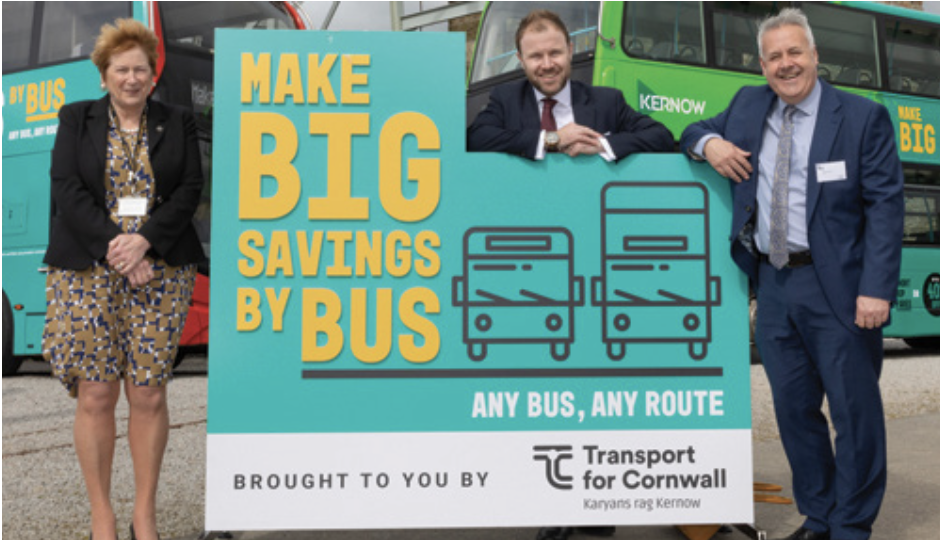
Cornwall was the first area to get government backing for fares reductions and rationalisation to make public transport more attractive. Other projects have followed as part of BSIP grants.

The Johnson Government said it wanted to understand if it was really true that the cost was putting people off using buses, and so they were giving Cornwall Council some money to reduce the bus fares to see what happens.
The first phase of the BFP focussed on developing consistent fares across most of the buses in Cornwall. Since January 2022, bus companies in Cornwall came together under the Transport for Cornwall umbrella to now accept each other’s tickets, so users can jump on and off any bus no matter who it’s operated by. This applies to both return tickets and period passes (those valid for a day or longer) on journeys that are wholly undertaken within Cornwall, and there are now the same fares across period passes available across Cornwall and allowing unlimited travel within the town zone on any operator’s service. The ‘child’ age range has been aligned across operators. This means that across the county’s biggest operators anyone under the age of 19 can buy a child ticket.
From 10th April 2022 bus fares changed further, becoming simpler to understand by the reduction of the number of tickets and fares that are available and consistent across operators and areas, and with a major county-wide reduction. For some tickets there was up to 44% saving, and on average around 30% across the county.
It was reported that more than 625,000 of the Cornwall reduced fares tickets were sold in the first four months between April and July. New technology introduced over the summer then meant passengers making contactless payments could ‘tap on and tap off’ - capping their payments no matter how many journeys they make, at £5 a day or £20 a week for bus travel in Cornwall.
Connor Donnithorne, Cornwall Council cabinet portfolio holder for transport, said: “Residents have previously told us that one of the biggest barriers to travelling by bus was the cost. This is another step in encouraging more people to look to more sustainable ways of travel.”
Claims of the success and popularity of the Cornish reduced bus fares pilot are said to have influenced the introduction of the national £2 maximum fare and the county’s fares changes under its Bus Service Improvement Plan and the results of a pilot project offering care leavers in Cornwall free bus travel were on the agenda for Transport Minister Richard Holden when he visited Cornwall in February.
The Buses Minister said the Government had invested £13.3 million to improve local bus services and a further £23.5 million to help cap the price of local bus journeys and keep travel affordable.
A devolution deal in 2015 had paved the way for the Council and bus companies to work together to deliver significant improvements for passengers under the single brand Transport for Cornwall.
There had since been a year-on-year growth in passenger numbers, interrupted only by the pandemic. The Fares cap at £5 per day or £20 per week was now running alongside the £2 flat fare single bus journey initiative. The Minister also heard care leavers at Lys Kernow explain the importance of the Cornwall pilot scheme to offer them free bus travel as part of a national ‘Transport for Freedom’ campaign to obtain free transport for care leavers.
As part of the campaign, Barnardo’s ran a pilot project in Cornwall to gauge the impact of free transport on the lives of care leavers with reported benefits including improved mental health, better access to work, training or study, getting to appointments and reducing isolation.
Other fares reductions and marketing approaches are also being supported under BSIP grantsaround the country. Amongst them Lancashire residents have benefited from lower fares on most bus services for evening and weekend travel from January 30. For evening travel, it now costs just £1 for a single trip after 7pm,whilst a new Weekender ticket means any ticket bought on a Saturday includes equivalent free travel on Sundays.
These discounted tickets will be available until at least March 2025 as part of Lancashire County Council’s Bus Services Improvement Plan, which has received DfT funding of £34.1 million for a range of measures
In East Sussex, BSIP support has meant the £5 single operator tickets sold on board or via an app have become a multi-operator county rider ticket, and accepted on most operators’ services including Stagecoach, Brighton & Hove Buses, Metrobus, Compass, and Cuckmere.
Under 19s pay £3.20 (36% discount) and those between 19 to 29 pay £3.75 (25% discount).
Other bus fare reductions include a Freedom Weekly Ticket coming down from £17.50 to £15 for for under 19s and providing unlimited travel on every bus in East Sussex for any seven days in a row at all times and days of the year. Meanwhile unacompanied under 19s pay £1 for a single fare after 6pm on school days and anytime on non-school days and up to four under 19s travel for free with one accompanying adult fare paying or concessionary pass passenger.
As part of Somerset’s £12m BSIP award, the Council introduced a £1 fare for any single journey in Taunton in December as a three year pilot, and figures from Somerset’s main operator First South suggest a 24 per cent increase in bus use in the town has followed. As part of a targeted approach with the aim of getting more passengers on buses in Taunton, the council hopes it will strengthen the case for further BSIP funding to support similar initiatives in other towns across Somerset. The £1 single fare applies to all journeys in the Taunton ‘zone’, including the park and ride sites.
The case for concessionary fares
The clearest ‘social case’ for providing free or reduced cost public transport are the concessions provided to those over (or under) a certain age, or having a disability of some kind. Children widely get free or half price fares, extended to students and other young people with discount rail travel schemes.
The English National Concessionary Travel Scheme (ENCTS) meanwhile presently provides statutory free transport for those aged 66 and over and travelling after 9.30am. However, just over three-quarters of local authorities allow the concession to be used before 9.30am. (London and Wales allow free bus use from the age of 60.) Over the last decade the average take up of the ENCTS outside London has been around 77% of the eligible population. This compares to over 90% for London’s more generous concessionary scheme, however, this will be significantly influenced by the lower age eligibility for London’s scheme.
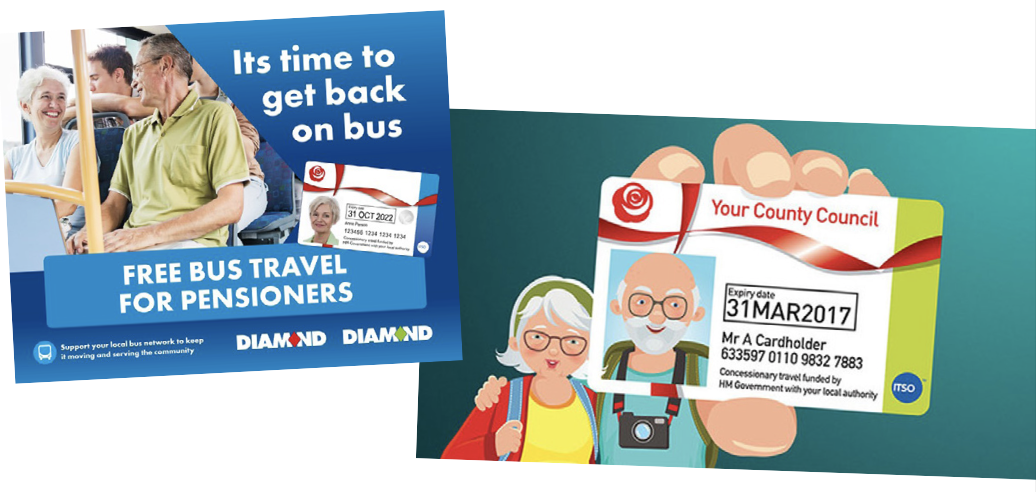
The average number of journeys per concessionary pass (including by disabled concessionary passes which make up around 10% of the total) varies by type of area as shown in figure 1. Even before the pandemic the number of trips per pass was steadily falling in each of the three types of areas shown. Between 2011 and 2019 it was down by 11% in London, 16% in non-metropolitan areas and 19% in metropolitan areas. In 2022, London pass use had recovered to 90% of its pre-pandemic levels while outside London it was only around 60%.
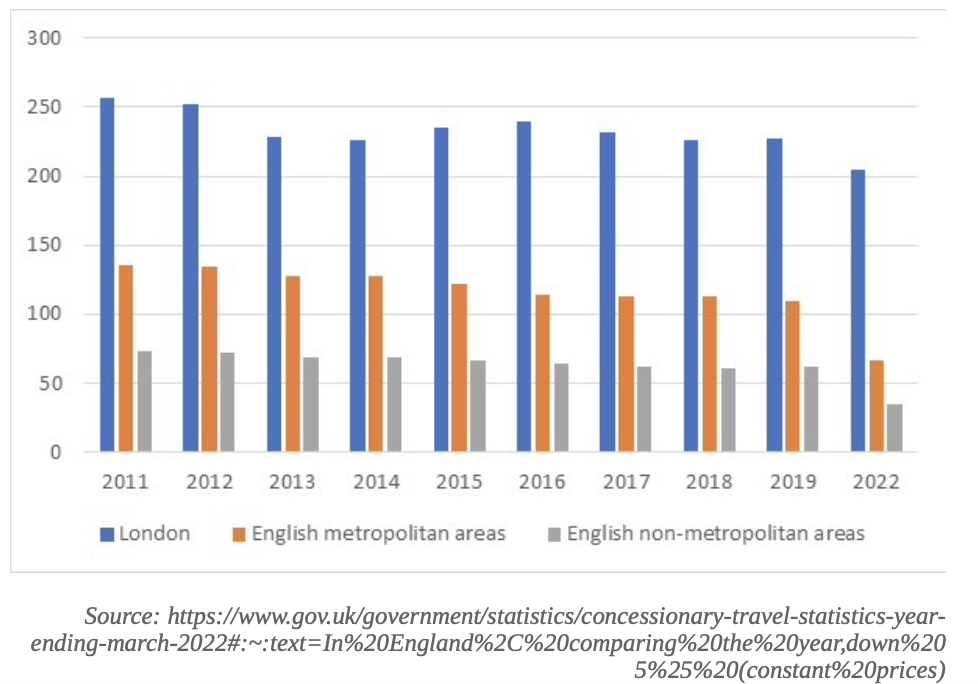
Figure 1: Annual number of trips made per concessionary pass by type of area
Not surprisingly the differences at a local level are even more extreme. At a county level just 16 trips are made per pass annually in Cornwall, rising to 57 for the Isle of Wight. In more urban areas, Brighton has the highest use at 163 trips per pass, followed by Nottingham with 134 and Southampton 100. Stoke on Trent on the other hand had 52 and Plymouth 58 (data is not available for all local authority areas).
The availability of a bus to use in the first place is one factor explaining these differences, but it also highlights that even when the service is free to use if it is not convenient compared to a car, people will not use it. This is clearly shown in figure 2 which shows the number of bus trips made by men and women aged 50-59, 60-69 and over 70 depending on the number of cars in the household.
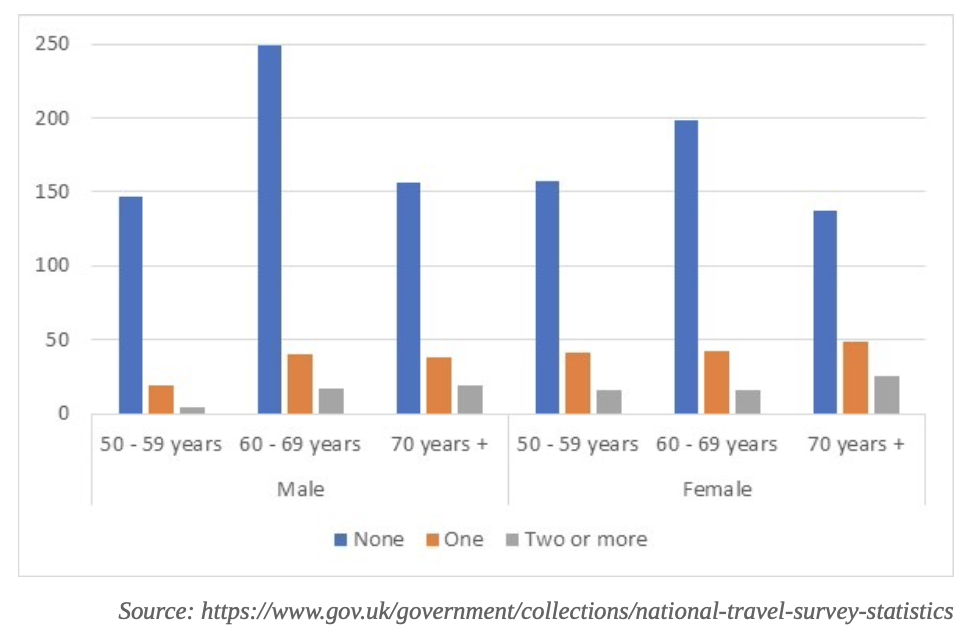
Figure 2: Bus use by age and number of cars in the household 2017-18
What is notable is the significant increase in bus travel for both men and women in households with no car in the age category 60-69 compared to those aged 50-59. This would imply that free bus travel generates additional trips. However, the increase in bus use for those living in households with a car is non-existent for women and very small for men aged 60-69 compared to those aged 50-59.
The 2021 Census allows us to hone in on individual year groups to see if there is any significant change in mode choice when people become eligible for free bus travel. Figure 3 shows the percentage of women aged from 62 to 69 who were commuting to work that travelled by bus by English region excluding London. While the percentages vary significantly between regions, less than 5% in the East of England to over 10% in the North East, there is little evidence of a material increase in bus use for those aged 66 and over compared to younger age groups. (Male bus use in these age groups is so low that it would be unwise to draw any conclusions from the data which broadly shows constant bus across each year of age.)
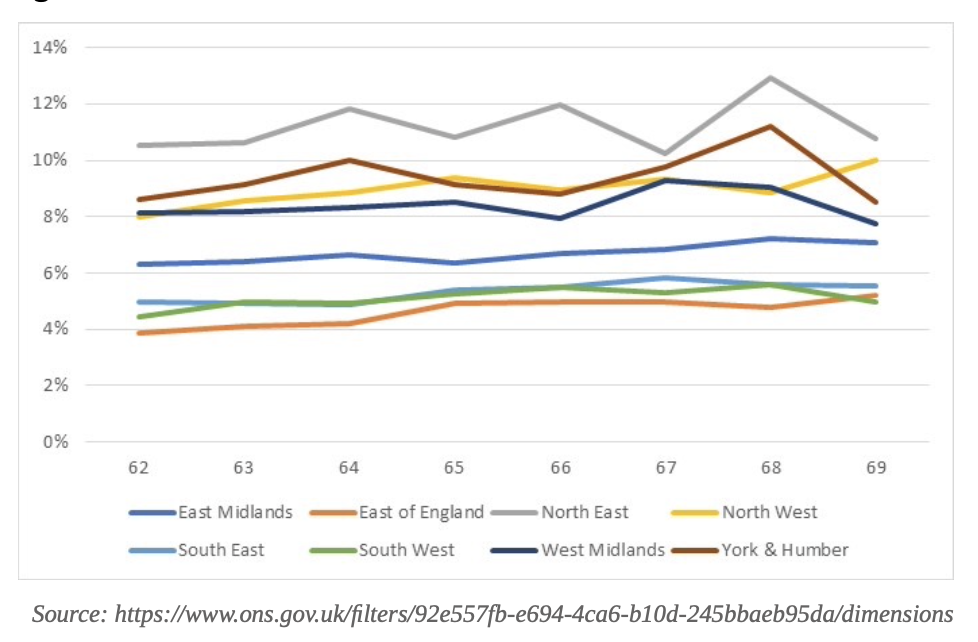
Figure 3: Percentage of female commuters who travel by bus – aged 62-69
Germany offers reduced price local transport across nation
From 1 May, passengers in Germany have been able to use a new 49-euro a month subscription ticket on local and regional public transport nationwide, brought in at the prompting of the Green members of the national coalition Government, and a follow-up to the immensely popular €9 (£7.90) monthly public transport ticket scheme run last year in a move aimed at getting passengers to switch to greener forms of transport.
The €49-(£42) a-month ticket covers regional rail, metro, trams and bus travel across Germany, though not inter-city ICE trains or long-distance coaches. The national government will cover half of the scheme’s annual cost of €3bn for the next three years, with the other half is paid for by Germany’s 16 federal states.
The transport minister, Volker Wissing, hailed the new ticket scheme as a “role model for the whole of Europe” that would boost public transport use. Wissing, of the liberal Free Democratic party (FDP) member of the three way coalition, has been under fire over the transport sector’s failure to meet carbon reduction targets.
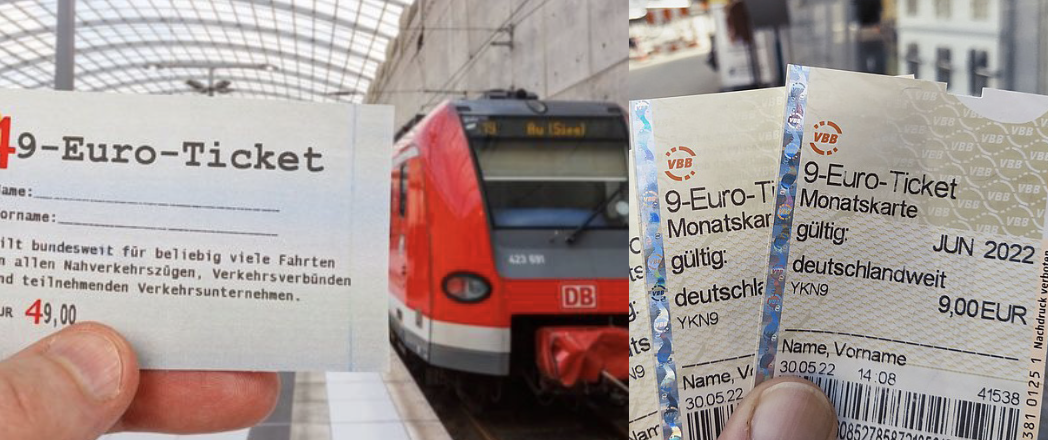
The original €9-a-month ticket scheme was put in place from June to the end of August last year to incentivise travellers to switch to greener forms of transport and give financial relief to consumers facing a cost of living crisis. With about half of Germany’s adult population having taken part in the scheme that the government subsidised with €2.5bn, the ticket was as popular as it was inexpensive.
Whether it had a significant positive impact on modal change or benefited the environment has been questioned: most Germans used the €9 ticket to travel around the country for leisure, while there has been little statistical evidence showing that those who commute by car changed their transport routines in any meaningful way.
The new ticket – being called “Germany ticket” by the government – is hence designed to be most attractive to people who commute in and out of larger cities, where most old subscription-based discount pass schemes are more expensive than €49 a month.
The ticket, available in digital form via a smartphone app or as a chip card, works on the basis of a subscription that can be cancelled before the 10th day of each month, meaning it may still pay off as a one-off investment for some holidays or weekend trips.
In the first full month of the nationwide 49€ Deutschland-Ticket, around 10 million customers took advantage of the offer (7 million subscriptions were sold in the first 10 days after it became valid, and the Deutsche Bahn website crashed. Half of these buyers, approximately 5 million passengers, switched from existing season tickets, while 4.3 million passengers were new subscribers who previously just used single tickets or season tickets without a subscription. Additionally, around 700,000 people became new customers who had not used public transport before, according to figures made public by the german local public transport operators’ body the VDV on 31st May.
The previous 9€ ticket issued in summer 2022 was bought by over 52 million people, with a claimed reduction in car use cutting carbon dioxide emissions by 1.8 million tonnes, according to VDV. Researchers at the University of Potsdam quoted by the World Economic Forum “found that air pollution levels fell by up to 7% in response to the introduction of the low-cost ticket”.
According to another study, almost 40 percent of respondents who currently possess or plan to purchase a Deutschland-Ticket expect to reduce their car usage, and estimates suggest that public transport could see an increase of around five percent in passenger numbers.
An issue highlighted also by VDV’s President Ingo Wortmann is that many people do not find adequate bus and rail services locally to be able to switch to public transport in the long term. The expansion and modernisation of the entire public transport system must remain at the top of the political agenda he says, and “In addition to the Deutschland-Ticket, we also need the Deutschland-offer in public transport”.
Among the key positives, however, is the clarity in fares provided by the new pass. A recent survey by PwC Germany indicated that a significant portion of respondents (54%) expressed confusion or uncertainty regarding the best ticket to use for their intended journey - a situation even more challenging for new customers, including tourists, with 60% reporting difficulties in navigating the fare structures in unfamiliar regions. The survey indicated that up to 40% of respondents would increase their usage of public transport if the available tickets were more clearly defined and understandable.
Due to Germany’s decentralised political system, tickets bought in different cities or regions come with different rules and add-ons. In the northern state of Schleswig-Holstein, for example, people travelling on a €49 ticket can also take a bicycle and a dog no bigger than a cat on the train with them for free.
While, in and around the southern city of Stuttgart, travellers can transfer their ticket subscription to friends, relatives or colleagues if they pay an additional €9.90. States such as Bavaria are offering discounts for students, trainees and those doing voluntary service, who will only have to pay €29 a month.
But though the €49 public transport ticket e pass was hailed by public transport leaders was the “biggest public transport reform in German history”, they have also warned that the low price is unsustainable, as they are squeezed by high inflation and though so far “politics has absorbed the difference to the previous income for the transport company,” as one out it a price hike seems likely from January 2024.
Any potential increase in price could meet with fierce political opposition, however.
If agreed to by transport companies, this rule would apply on weekends, holidays, and after 8pm on weekdays.
...help in Spain too
In Spain, meanwhile, having already halved the cost of public transport nationwide, slashed VAT and cut tax on fuel, the Spanish government has now made a huge number of short- and medium-distance train journeys totally free – for regular passengers, anyway.
The scheme was announced last year by Spanish prime minister Pedro Sánchez, who said that all Cercanías (commuter train), Rodalies (commuter routes in Catalonia) and Media Distancia routes (mid-distance regional lines, covering journeys of less than 300km) run by the national rail operator Renfe were to be free from September 1 to December 31 2022. Having proved incredibly popular, the scheme was subsequently extended, and is now due to finish this December.
It is worth noting that the 100 percent discount will be on multi-trip tickets between two regular destinations, and single fares are not included. The scheme is therefore aimed at regular commuters rather than leisure travellers or tourists who want to visit multiple destinations, with the primary aim of getting people to switch away from private transport and, tackling the climate emergency, as well as the cost-of-living crisis.
Various Spanish regional governments are also funding discounts of up to 60 percent on a variety of public transport, including metros, buses and trams.
The Tallinn free fares project
Detailed survey work of users of Tallinn’s free public transport system, which was introduced (for local residents) in 2013, tell a similar story to the analysis of other free or low cost public transport schemes. Yes, there is mode-shift, but the biggest mode-shift tends to be from walking. In the case of Tallinn there was a 5-percentage point shift from walking and just 3 percentage points from car use, see figure 4. Even that is probably an over optimistic assessment as other measures were put in place to restrict car use at the same time. While a later Estonia National Audit Office report highlighted car’s mode share had subsequently increased.
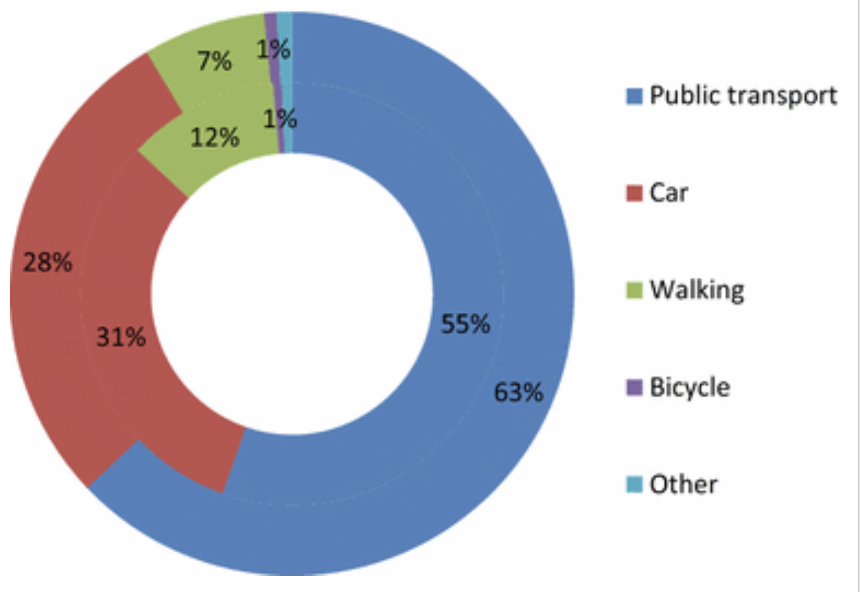
Source: Cats, Susilo & Reimal
Figure 4: Tallinn mode split in 2012 (inner-ring), pre free public transport and 2013 (outer-ring), post public transport
The capital of Estonia introduced free public transport after the populist mayor Edgar Savisaar called a referendum on the decision, dismissed by critics at the time as a political stunt that the city couldn’t afford.
Three years on Savisaar had been suspended amid allegations of corruption, but the city remains committed to the programme, which has some other dimensions underpinning its creation.
To enjoy Tallinn’s buses, trams, trolley buses and trains for free you must be registered as a resident, which means that the municipality gets a €1,000 share of your income tax every year, Residents only need to pay €2 for a “green card” and then all their trips are free.
Since the scheme launched, an additional 25,000 people have registered as residents in the city that previously had a population of 416,000. That has meant more money for the city of Tallinn, but less for the rest of the country. This suited the mayor’s office, and alongside a straight bid for political popularity was one of the key motivations for rolling out the project i.e. easing the burden on people’s wallets, rather than improving the balance of the city’s mobility.
The Audit Office analysis concluded that free public transport had not reached its goal to reduce car journeys. Whilst public transport use numbers had increased, still more than half of all trips to work are done by car.
“What is positive is that the decline in the share of public transport users has stopped for a couple of years,” stated Auditor General Janar Holm. “Unfortunately, not a significant number of new users have been attracted to public transport despite the fact that the state has allocated more and more funds to cover the costs of bus transport, and allowed people to travel free of charge.”
Is there a clear overall message for fares policy?
Looking at all these elements to the question of setting the most appropriate levels of public transport fares must inevitably lead to a complex set of potential objectives and justifications though a pretty clear conclusion that free or low cost public transport in itself does not appear to be an effective means of achieving the transport policy aim of achieve meaningful mode shift.
But it may be a bit more nuanced than that. The comparative attractiveness of public and private transport is often down to the very low perceived marginal cost of a car journey - and the way users evaluate the relative purchasing options and expenditures. If the only cost being considered is the price of fuel, then the convenience of the car and the relatively ‘unconscious’ way the transaction for an individual journey is made poses a real challenge to the public transport alternative. In that context, re-casting the levels and structures of bus and rail fares with an element of public support, and some simple packages of multi-operator and easy to use fares offers might have a part to play in rebalancing the relative appeal of the car and the alternatives to it.
Reference: Cats, O., Susilo, Y.O. & Reimal, T. The prospects of fare-free public transport: evidence from Tallinn. Transportation 44, 1083–1104 (2017)
About the authors of this article
TAPAS is grateful for the expert input to this article provided by the contributors. The piece was compiled based on material provided by John Siraut, director of economics at Jacobs, Peter White, emeritus professor of Public Transport at the University of Westminster, and Peter Stonham, editorial director of TAPAS.
Further input to the discussion - particularly examples of successful fares initiatives would be welcomed.
This article was first published in LTT magazine, LTT870, 6 June 2023.
You are currently viewing this page as TAPAS Taster user.
To read and make comments on this article you need to register for free as TAPAS Select user and log in.

Log in